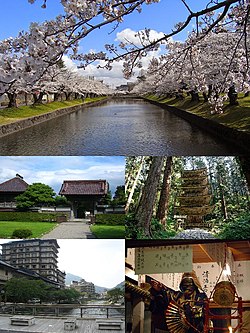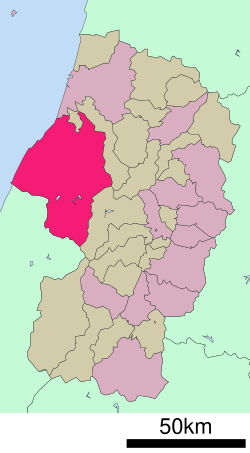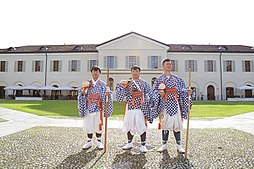Tsuruoka
This article needs additional citations for verification. (November 2013) |
Tsuruoka
鶴岡市 | |
|---|---|
 Top:Cherry blossom in Tsuruoka Park, Middle left:Chido hall of Tsuruoka, Middle right:Five story pagoda in Mount Haguro, Bottom left:Atsumi Spa, Bottom right:Ogisai Kurokawa Noh | |
 Location of Tsuruoka in Yamagata Prefecture | |
| Coordinates: 38°43′38″N 139°49′36″E / 38.72722°N 139.82667°E | |
| Country | Japan |
| Region | Tōhoku |
| Prefecture | Yamagata |
| First official recorded | 593 AD |
| City Settled | October 1, 1924 |
| Government | |
| • Mayor | Osamu Minagawa (From October 2017) |
| Area | |
• Total | 1,311.53 km2 (506.38 sq mi) |
| Population (February 2020) | |
• Total | 125,389 |
| • Density | 96/km2 (250/sq mi) |
| Time zone | UTC+9 (Japan Standard Time) |
| Phone number | 0235-25-2111 |
| Address | 9-25, Babachō, Tsuruoka-shi, Yamagata-ken 997-8601 |
| Climate | Cfa |
| Website | Official website |
| Symbols | |
| Flower | Sakura |
| Tree | Japanese beech |

Tsuruoka (鶴岡市, Tsuruoka-shi) is a city in Yamagata Prefecture, Japan. As of 31 January 2020[update], the city had an estimated population of 125,389 in 49,024 households,[1] and a population density of 95.74 persons per km². The total area of the city is 1,311.53 square kilometres (506.38 square miles). Tsuruoka is the biggest city in Tōhoku region in terms of land area.[2]
Today's Tsuruoka is the result of the fusion of several neighborhoods around the center of the city such as Atsumi, Asahi, Fujishima, Kushibiki, and Haguro in 1953.[3]
Geography
[edit]Tsuruoka is located on the coast of Yamagata Prefecture bordering the Sea of Japan and has some locally popular beaches such as Yunohama and Sanze. All three of the Three Mountains of Dewa are at least partially within the city limits.
Two main rivers run through Tsuruoka, the Akagawa River (赤川, literally "Red River"), and the Mogami River.
Neighboring municipalities
[edit]Climate
[edit]Tsuruoka has a Humid continental climate (Köppen climate classification Cfa) with large seasonal temperature differences, with warm to hot (and often humid) summers and cold (sometimes severely cold) winters. Precipitation is significant throughout the year but is heaviest from August to October. The average annual temperature in Tsuruoka is 12.9 °C (55.2 °F). The average annual rainfall is 2,191.4 mm (86.28 in) with December as the wettest month. The temperatures are highest on average in August, at around 25.3 °C (77.5 °F), and lowest in January, at around 1.7 °C (35.1 °F).[4] The region is known for its heavy snowfalls during the winter, and people living in Sekigawa and Atsumi's neighborhoods can expect up to 2 meters of snow which after removal creates very particular snow walls standing high along the road. The first snows usually come in late November but the real peak is generally around January. The red leaves appear generally at the end of October and end in mid-November.
| Climate data for Tsuruoka (1991−2020 normals, extremes 1976−present) | |||||||||||||
|---|---|---|---|---|---|---|---|---|---|---|---|---|---|
| Month | Jan | Feb | Mar | Apr | May | Jun | Jul | Aug | Sep | Oct | Nov | Dec | Year |
| Record high °C (°F) | 15.2 (59.4) |
21.4 (70.5) |
24.4 (75.9) |
30.4 (86.7) |
32.3 (90.1) |
33.8 (92.8) |
37.8 (100.0) |
39.9 (103.8) |
38.2 (100.8) |
31.7 (89.1) |
25.2 (77.4) |
19.5 (67.1) |
39.9 (103.8) |
| Mean daily maximum °C (°F) | 4.4 (39.9) |
5.1 (41.2) |
9.1 (48.4) |
15.7 (60.3) |
21.2 (70.2) |
24.8 (76.6) |
28.2 (82.8) |
29.9 (85.8) |
26.0 (78.8) |
20.0 (68.0) |
13.7 (56.7) |
7.5 (45.5) |
17.1 (62.9) |
| Daily mean °C (°F) | 1.7 (35.1) |
1.9 (35.4) |
4.9 (40.8) |
10.4 (50.7) |
16.0 (60.8) |
20.1 (68.2) |
23.9 (75.0) |
25.3 (77.5) |
21.3 (70.3) |
15.3 (59.5) |
9.5 (49.1) |
4.2 (39.6) |
12.9 (55.2) |
| Mean daily minimum °C (°F) | −0.9 (30.4) |
−1.1 (30.0) |
1.0 (33.8) |
5.3 (41.5) |
11.1 (52.0) |
16.0 (60.8) |
20.3 (68.5) |
21.4 (70.5) |
17.3 (63.1) |
11.0 (51.8) |
5.3 (41.5) |
1.2 (34.2) |
9.0 (48.2) |
| Record low °C (°F) | −9.6 (14.7) |
−11.6 (11.1) |
−11.0 (12.2) |
−4.3 (24.3) |
2.2 (36.0) |
6.9 (44.4) |
11.5 (52.7) |
13.7 (56.7) |
7.2 (45.0) |
1.5 (34.7) |
−3.3 (26.1) |
−11.3 (11.7) |
−11.6 (11.1) |
| Average precipitation mm (inches) | 218.3 (8.59) |
134.8 (5.31) |
130.0 (5.12) |
106.8 (4.20) |
119.9 (4.72) |
124.3 (4.89) |
220.2 (8.67) |
198.9 (7.83) |
184.6 (7.27) |
207.7 (8.18) |
267.0 (10.51) |
278.7 (10.97) |
2,191.4 (86.28) |
| Average precipitation days (≥ 1.0 mm) | 25.4 | 20.8 | 18.8 | 13.5 | 11.9 | 11.2 | 13.8 | 12.2 | 13.9 | 15.8 | 20.2 | 24.9 | 202.4 |
| Mean monthly sunshine hours | 24.6 | 44.7 | 109.2 | 171.1 | 199.3 | 177.1 | 155.0 | 198.5 | 150.8 | 121.5 | 77.7 | 35.8 | 1,465.3 |
| Source: Japan Meteorological Agency[5][4] | |||||||||||||
| Climate data for Nezugaseki Pass, Tsuruoka (1991−2020 normals, extremes 1976−present) | |||||||||||||
|---|---|---|---|---|---|---|---|---|---|---|---|---|---|
| Month | Jan | Feb | Mar | Apr | May | Jun | Jul | Aug | Sep | Oct | Nov | Dec | Year |
| Record high °C (°F) | 15.3 (59.5) |
20.4 (68.7) |
24.9 (76.8) |
28.8 (83.8) |
29.0 (84.2) |
33.1 (91.6) |
37.6 (99.7) |
40.4 (104.7) |
39.1 (102.4) |
30.6 (87.1) |
25.4 (77.7) |
20.7 (69.3) |
40.4 (104.7) |
| Mean daily maximum °C (°F) | 5.1 (41.2) |
5.5 (41.9) |
8.8 (47.8) |
14.5 (58.1) |
19.7 (67.5) |
23.2 (73.8) |
26.9 (80.4) |
28.9 (84.0) |
25.3 (77.5) |
19.6 (67.3) |
13.9 (57.0) |
8.4 (47.1) |
16.7 (62.0) |
| Daily mean °C (°F) | 2.5 (36.5) |
2.5 (36.5) |
5.1 (41.2) |
10.0 (50.0) |
15.2 (59.4) |
19.2 (66.6) |
23.3 (73.9) |
24.9 (76.8) |
21.1 (70.0) |
15.5 (59.9) |
10.1 (50.2) |
5.2 (41.4) |
12.9 (55.2) |
| Mean daily minimum °C (°F) | −0.1 (31.8) |
−0.3 (31.5) |
1.5 (34.7) |
5.6 (42.1) |
10.9 (51.6) |
15.6 (60.1) |
20.3 (68.5) |
21.6 (70.9) |
17.6 (63.7) |
11.8 (53.2) |
6.5 (43.7) |
2.2 (36.0) |
9.4 (49.0) |
| Record low °C (°F) | −6.3 (20.7) |
−7.5 (18.5) |
−6.7 (19.9) |
−3.7 (25.3) |
1.8 (35.2) |
7.0 (44.6) |
10.7 (51.3) |
12.9 (55.2) |
7.2 (45.0) |
2.8 (37.0) |
−1.3 (29.7) |
−6.3 (20.7) |
−7.5 (18.5) |
| Average precipitation mm (inches) | 171.0 (6.73) |
107.5 (4.23) |
118.4 (4.66) |
115.0 (4.53) |
130.4 (5.13) |
137.7 (5.42) |
225.4 (8.87) |
201.3 (7.93) |
187.6 (7.39) |
198.6 (7.82) |
227.7 (8.96) |
217.3 (8.56) |
2,037.9 (80.23) |
| Average precipitation days (≥ 1.0 mm) | 24.3 | 19.0 | 17.2 | 13.0 | 11.9 | 10.7 | 13.7 | 11.1 | 13.5 | 15.5 | 19.2 | 23.1 | 192.2 |
| Mean monthly sunshine hours | 31.3 | 52.3 | 108.7 | 161.8 | 194.4 | 182.0 | 157.5 | 194.5 | 147.6 | 126.3 | 79.1 | 37.6 | 1,473.2 |
| Source: Japan Meteorological Agency[6][7] | |||||||||||||
Demographics
[edit]Per Japanese census data,[8] the population of Tsuruoka has declined in recent decades.
| Year | Pop. | ±% |
|---|---|---|
| 1920 | 126,228 | — |
| 1930 | 136,332 | +8.0% |
| 1940 | 142,150 | +4.3% |
| 1950 | 172,467 | +21.3% |
| 1960 | 167,810 | −2.7% |
| 1970 | 153,173 | −8.7% |
| 1980 | 153,330 | +0.1% |
| 1990 | 150,840 | −1.6% |
| 2000 | 147,546 | −2.2% |
| 2010 | 136,623 | −7.4% |
| 2020 | 125,347 | −8.3% |
History
[edit]The area of present-day Tsuruoka was part of ancient Dewa Province. In the Edo period, it served as the capital of the Shōnai Domain. It was a minor port for the kitamaebune coastal trade.
After the start of the Meiji period, the area organized as Tsuruoka Town under Nishitagawa District, Yamagata Prefecture in 1878. It was elevated to city status on October 1, 1924, becoming Japan's 100th city. In 1955, the city expanded by annexing the town of Kamo and nine neighboring villages. The town of Oyama was annexed by Tsuruoka in 1963.
On October 1, 2005, the towns of Fujishima, Haguro and Kushibiki, and the village of Asahi (all from Higashitagawa District), and the town of Atsumi (from Nishitagawa District) were merged into Tsuruoka.[9][10]
Government
[edit]Tsuruoka has a mayor-council form of government with a directly elected mayor and a unicameral city legislature of 24 members. The city contributes five members to the Yamagata Prefectural Assembly. In terms of national politics, the city is part of Yamagata District 3 of the lower house of the Diet of Japan.
Economy
[edit]Tsuruoka has a mixed economy based on light manufacturing, commercial services, agriculture, and commercial fishing.
Education
[edit]Tsuruoka has 26 public elementary schools and 11public middle schools operated by the city government and six public high schools operated by the Yamagata Prefectural Board of Education. There are also two private high schools. The prefecture also operates two special education schools for the handicapped.
Colleges and universities
[edit]- Keio University, Institute for Advanced Biosciences (Tsuruoka Town Campus and Metabolome Campus)
- Tohoku University of Community Service and Science (Tsuruoka Campus)
- Tsuruoka National College of Technology
- Yamagata University, Faculty of Agriculture
High schools
[edit]
|
|
Junior high schools
[edit]
|
|
Elementary schools
[edit]
|
|
|
Health care
[edit]- Tsuruoka Shonai Hospital
- Tsuruoka Kyoritsu Hospital
- Yutagawa Onsen Rehabilitation Medical Center
Transportation
[edit]Airports
[edit]Railway
[edit]![]() East Japan Railway Company - Uetsu Main Line
East Japan Railway Company - Uetsu Main Line
- Nezugaseki - Koiwagawa - Atsumi Onsen - Iragawa - Kobato - Sanze - Uzen-Mizusawa - Uzen-Ōyama - Tsuruoka - Fujishima
Highway
[edit] Yamagata Expressway: Yudonosan, Shōnai Asahi, Tsuruoka interchanges
Yamagata Expressway: Yudonosan, Shōnai Asahi, Tsuruoka interchanges Nihonkai-Tōhoku Expressway
Nihonkai-Tōhoku Expressway National Route 7
National Route 7 National Route 112
National Route 112 National Route 345
National Route 345
Media
[edit]TV
[edit]- NHK Tsuruoka Broadcast Station
Newspapers
[edit]- Shonai Nippo
Culture
[edit]The Mountain Spirit
[edit]Tsuruoka is mostly known for its "Three Mountains of Dewa", which refers to Mt. Haguro, the smallest mount that culminates at only 436m high; Mt. Gassan, the highest mount at 1984m; and Mt. Yudono, at 1500m.
Yamabushi and Shugendô
[edit]This section needs additional citations for verification. (September 2024) |

Those three mounts are considered the core of the Shugendô practice. Shugendô (修験道, lit. The way of the ascetic practice) is often perceived as a form of syncretism of Shintô and Buddhism. The Yamabushi (山伏, lit. "the men who sleep in the Mountain"), or men who practice shugendô, believe in Buddha but also believe that a god resides in all things that exist in nature. Yamabushi wear checkered vests and blow trumpet shells to communicate with their peers and to keep the bad spirits away. They aim to protect the mountain and to live a sinless life connected to nature.[11]
The pilgrimage of all three mountains is done in that sense. The three mountains symbolically represent death and rebirth. By going down and up the 2466 stone stairs of Mt. Haguro, people can experience a symbolic "death" and "rebirth", after which they can access to the world of the dead represented by Mt. Gassan and its foggy landscapes; lastly, they can purify their body and soul in Mt. Yudono's natural hotsprings.

Shôjin ryôri (精進料理, lit. "food for spiritual elevation"), a vegan food traditionally consumed by Yamabushi, uses no animal product but sansai 山菜 ("Mountain vegetables") instead, as well as local rice, handmade gomadôfu (sesame-flavoured tôfu), bamboo sprouts, vinegared chrysanthemum flowers and mushrooms. There exists many different types of shôjin ryôri depending on the shukubo (temples that also welcome travellers for the night) that serves it, but it usually consists of many small dishes accompanied with miso soup and white rice.
National Treasures
[edit]Mt. Haguro hosts The Five-Storied Pagoda (gojûnotô 五重塔), one of Japan's National Treasures. The pagoda's central pillar protects it from earthquakes, which inspired Tokyo's Skytree's architecture. Also in the grounds of Mt. Haguro is the Jiji-sugi 爺杉 ("Grandpa cedar"), a 30m high cedar that exists for more than 1000 years.
Culinary culture
[edit]Heritage and creativity
[edit]In 2014, Tsuruoka has been registered as a UNESCO Creative City of Gastronomy. Its more than 50 species of "ancestral food" (zairai sakumotsu 在来作物) that exist and remain intact for several centuries now are one of the reasons why the city has received this title. Among these there are: minden nasu 民田なす (a round eggplant with a long and thin hat), karatori imo からとりいも (spiciness-sweetener potato), atsumi kabu 温海かぶ (Atsumi turnip, a red turnip that grows on sharp slopes), ootaki carrot 大滝ニンジン,[12] etc. The presence of such ancient food is not the only reason why Tsuruoka has been registered as a Creative City of Gastronomy. Its particular way to cook these ingredients was even more determinant. Tsuruoka's most known specialties are: kandarajiru 寒鱈汁 (a soup containing black cod fished during the winter – the period when it is supposed to be tastier), gomadôfu ごま豆腐 (sesame-flavoured tôfu), tochimochi とちもち (chestnut flavoured pound rice cake), kitsunemen キツネ面 (fox mask shaped black sugar biscuit), etc.[13]
The city is also known for its large variety of soups (it is said the harsh cold during the winter is the reason why there are so many types of hot soups in Tsuruoka),[14] apart from kandarajiru, there is takenokojiru タケノコ汁 (Mt Gassan bamboo soup), imoni 芋煮 (potato soup), nattôjiru 納豆汁 (nattô based soup), môsô jiru (another type of bamboo soup).
Peas
[edit]Tsuruoka is known for dadacha-mame (だだちゃ豆), a species of soybean, which have been called "the king of edamame"; they are also used for other products such as nattō and in manjū. There are two theories as to the origin of the name: one is that it derives from dadacha, the Shonai dialectical word for "father" – gagacha is the dialectical word for "mother", while the other is that the beans came from Date, Fukushima, and were originally called Date-no-chamame, which became Date-chamame and then Dadacha-mame.[15]
Dadachamame are used in any kind of meal: sweet, salty, spicy, bitter, sour, just boiled, crushed, grilled, and in sauces.
Dadakko (だだっ子), are small cakes which contain a sweet dadachamame paste. Dadappai (だだっパイ) are small dadachamame pasted inside a puff pastry. There are also dadachamame flavored ice creams, cookies, biscuits, creams.
Seafood
[edit]Tsuruoka and the whole region of Shônai benefit from a large variety of fishes and sea food coming from the Sea of Japan. Among all the local sea foods you can find in Tsuruoka, there are: Cherry salmon, Japanese seabream, blue crab, littlemouth flounder, flatfish, black rockfish, tonguefish, flying squid, oyster, sea robin, sandfish, Japanese codfish, and others. The huge variety of fresh local fishes and seafood in Tsuruoka had contributed to the local sushi shops' good reputation, but it has also helped constitute a very particular kind of "family gastronomy", where fishes hold a very important place.[16]
Rice
[edit]The rice cultivated in Tsuruoka and more generally in Shonai region has been recognized for its strong umami taste. In 2010, searchers from Keiô University's Institute for Advanced Biosciences 慶應義塾大学先端生命科学研究所 have proven Tsuyahime local rice brand contained 1.5x more umami taste than the common other brands of rice thanks to the studies of metabolomes.[17][18]
Arts and crafts
[edit]The city is literally surrounded by plains, forests and mountains. Thus, wood and grass were largely used in all kinds of crafts. As for architecture, thatch-roofed houses (kayabukiyane かやぶき屋根) are one of the symbols of the city. Some of them remained in good condition through centuries now as for example Tasôminka 多層民家 (the several-layered house), a traditional farmer house from Meiji period, and the house in Chidô Museum 致道博物館.
Concerning clothing, shinaori しな織り, is a traditional weaving style from tree bark that is still performed these days. The items created with this solid and firm thread are very resistant and waterproof.
Local attractions
[edit]- Yamabushi Training at Ideha Culture Museum (いでは文化記念館, "Ideha Bunka Kinenkan")
- Mt. Haguro
- Zenpō Temple (善宝寺, - Where, in 1990, a carp fish with a human-like face was seen in a pond on the temple grounds.[19])
- Chido Museum (到道博物館,“Chido Hakubutsukan”)
- Shōnai Shrine
- Yutagawa Hot Spring
- Yunohama Hot Spring
- Atsumi Hot Spring
- Dewa-no-Yuki Shuzō Museum (Dewanoyuki Sake Brewing Museum)
- Tsuruoka Art Forum
- Dewa Shōnai Kokusai Mura International Forum and the Amazon Folk Museum
- Gassan Asahi Museum
- Tsuruoka Kamo Aquarium (加茂水族館, “Kamo-Suizokukan”.This is registered in Guinness for the number of jellyfish exhibits.)
Local events
[edit]- Saitansai (New Year Ceremony) in Mt. Haguro Shrine - January 1
- Ogisai Kurokawa Noh (Noh Festival) in Kushibiki - February 1 to 2
- Oyama Sake Festival - Middle of February
- Mt. Yudono Ski Festival in Mt. Yudono - From middle to late February
- Tsuruoka Hinamatsuri in Shonai Temple and Chido Museum - March
- Tsuruoka Sakura Festival in Tsuruoka Park - From middle to late April
- Tulip Festival in Ikoi Village Shonai - From late April to Early May
- Amazon Kid Festival in Gassan Asahi Village - May 3 to 5
- Ceremony for Women and Children in Mt. Haguro Shrine - May 5
- Kinen-sai (Prayer service for a good crop) in Mt. Haguro Shrine - May 8
- International Nordic Walk in Yunohama - Middle of May
- Tenjin Festival - May 25
- Oyama Dog Festival - June 5
- Yutagawa Hot Spring Hotaru Matsuri (Firefly Festival) - June 15 to August 10
- Flower Festival in Mt. Haguro - July 15
- Gassan Shrine Festival in Mt. Gassan - July 15
- International Bungee jumping in Gassan Asahi Village - Middle of July
- Edamame Shop Open in Shirayama - Late July to Late August
- Akagawa Fireworks Festival - Middle of August
- Oku no Hosomichi National Haiku Competition at Ideha Bunka Kinenkan - Middle of September
- Experience:Yamabushi Training at Ideha Bunka Kinenkan - Middle of September
- Miss Shonai Contest - Late October
- Shonai Hyakuman-goku Festival - Early November
- Shôreisai 松例祭 - Last day of December. Through different rites involving trees and fires, Yamabushi pray for a good rice harvest and the good health of the crops.
International relations
[edit]Sister cities
[edit]Tsuruoka is twinned with:
 Kagoshima, Kagoshima, Japan[20]
Kagoshima, Kagoshima, Japan[20] Kikonai, Hokkaido, since April 27, 1989
Kikonai, Hokkaido, since April 27, 1989 La Foa, New Caledonia[21]
La Foa, New Caledonia[21] New Brunswick, New Jersey, United States, since June 10, 1960
New Brunswick, New Jersey, United States, since June 10, 1960 Shangzhi, Heilongjiang, China[21]
Shangzhi, Heilongjiang, China[21]
Notable people from Tsuruoka
[edit]- Ryo Chonan, mixed martial artist
- Shuhei Fujisawa, writer
- Takashi Ishikawa, sumo wrestler
- Kanji Ishiwara, general in the Imperial Japanese Army
- Yuya Hasegawa, professional baseball player
- Ishirō Honda, movie director
- Koichi Kato (LDP), politician
- Rentaro Kita, musician
- Saiichi Maruya, writer and literary critic
- Satō Tetsutarō, admiral in the Imperial Japanese Navy
- Shin Togashi, movie director
- Kashiwado Tsuyoshi, sumo wrestler
- Shōichi Watanabe, English scholar
- Tomegoro Yoshizumi, spy and defector to Indonesia
References
[edit]- ^ Tsuruoka City official statistics (in Japanese)
- ^ "山形県鶴岡市はこんなところ | ぐるたび". gurutabi.gnavi.co.jp (in Japanese). Retrieved 2017-11-13.
- ^ City, Tsuruoka. 鶴岡市の沿革 鶴岡市. www.city.tsuruoka.lg.jp (in Japanese). Retrieved 2017-11-13.
- ^ a b 気象庁 / 平年値(年・月ごとの値). JMA. Retrieved March 25, 2022.
- ^ 観測史上1~10位の値(年間を通じての値). JMA. Retrieved March 25, 2022.
- ^ 観測史上1~10位の値(年間を通じての値). JMA. Retrieved March 25, 2022.
- ^ 気象庁 / 平年値(年・月ごとの値). JMA. Retrieved March 25, 2022.
- ^ Tsuruoka population statistics
- ^ 住民基本台帳人口移動報告年報 [Annual Report on Population Movement in the Basic Resident Register] (in Japanese). 総務庁統計局. 2005. p. 136.
- ^ 名寄市役所. "北海道名寄市| 姉妹都市「山形県鶴岡市」との交流事業". 北海道名寄市 (in Japanese). Retrieved 2024-02-07.
平成17年10月1日に、鶴岡市・羽黒町・櫛引町・朝日村・温海町と藤島町が合併し、新「鶴岡市」となりました。
- ^ "修験道とは …「自然と人間」". Tendaijimon Sect. Retrieved 9 September 2024.
- ^ Tsuruoka UNESCO Creative City of Gastronomy. pp. 69–70.
- ^ Tsuruoka Creative city of Gastronomy. p. 55.
- ^ Tsuruoka Creative city of Gastronomy. p. 59.
- ^ Yamagata foods: Dadacha-mame
- ^ Tsuruoka UNESCO Creative City of Gastronomy. p. 70.
- ^ "朝日新聞 10/19 「つや姫のうまさ、秘密は「バランス」 慶応大など研究」".
- ^ "「メタボローム解析」が拓く未来の健診――わずかな唾液や血液、尿の検査で、すい臓がんからうつ病まで一挙に早期発見する".
- ^ Metropolis, "Fortean Japan", 27 June 2008, p. 12.
- ^ 姉妹・友好・兄弟都市 [Twin cities]. Kagoshima International Affairs Division (in Japanese). Archived from the original on 2013-06-02. Retrieved 2013-08-08.
- ^ a b "International Exchange". List of Affiliation Partners within Prefectures. Council of Local Authorities for International Relations (CLAIR). Archived from the original on 22 December 2015. Retrieved 21 November 2015.
External links
[edit]- Official Website (in Japanese)
- Official tourism website (in Japanese)
- Official English website



